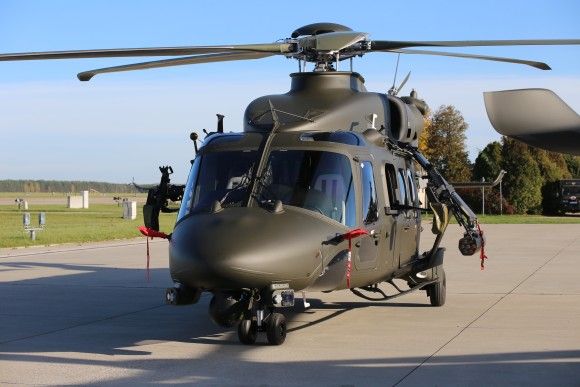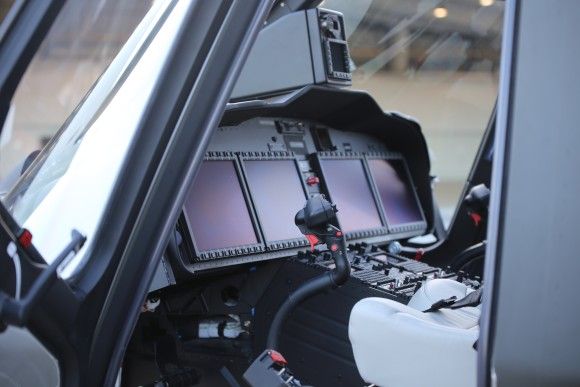Air Cavalry Brigade takes delivery of AW149 helicopters

Photo. Maciej Szopa/Defence24
The first two (out of 32 ordered) AW149 battlefield support helicopters were ceremonially transferred to the Armed Forces at the Tomaszów Mazowiecki Military Airfield in Nowy Glinnik. These machines were manufactured by Polish workers, who are being trained in Italy. The construction of a new assembly line at PZL-Świdnik is underway.
The helicopters were presented with side-mounted machine guns and launchers for 70 mm rockets (both unguided and laser-guided) suspended under the side pylons. The machines were also equipped with rails for mounting Hellfire II anti-tank guided missiles.
The ceremony was attended by the Minister of National Defense, Mariusz Błaszczak. In his view, the war in Ukraine and conflicts in the Middle East and Asia mean that „the prospects for the development of the situation in the international arena are not good.” He added that „The only effective response to threats is to strengthen the Polish Army. Therefore, it is with great satisfaction that I am here to show two of the 32 AW149 family helicopters that are already in service with the 25th Air Cavalry Brigade”.

Photo. Maciej Szopa/Defence24
„These machines, as we learned about them during training, thanks to their advanced avionics, allow crews to redirect a significant part of their attention from classic piloting tasks to the needs of battlefield tactics. Their network-centric capabilities allow us to connect to NATO systems to fully implement multi-domain tasks in a combined arms environment,” explained the head of training of the 7th Aviation Squadron (part of the 25th Brigade), Captain Miłosz Tomaszkiewicz.
Another important aspect of the AW149 is the increased night fighting capability. „Today begins a completely new story for our squadron. Today we are celebrating, but from tomorrow we will return to hard work because we realize that this system has cost taxpayers a lot. We want to repay this effort with the highest possible level of professionalism. Today, for the 7th Aviation Squadron, the horizon is no longer a border, but simply a point on the flight route,” emphasized Capt. Tomaszkiewicz.

Photo. Maciej Szopa/Defence24
Deputy Minister of Finance Artur Soboń emphasized that this is major milestone not only from the point of view of the modernization of the Armed Forces and the security of the country. „It is also an extremely important day for Świdnik, for the Lublin Voivodeship, because such large contracts - and this one is worth over 8 billion złoty - are not an everyday occurrence for Lublin companies. (…) In practice, this also means a good day for PZL Świdnik itself, for the 300 subcontractors working with it, and for new jobs, because thanks to this contract, about a thousand more jobs were created in the company and outside it,” he said.
The contract for 32 AW149 units was signed in July last year. The delivery of the first units to the Armed Forces took place very quickly. An Italian-owned AW149 was demonstrated at August 15 parade on the occasion of the Polish Army Day, and then at the Radom Air Show. The contract value is PLN 8.25 billion gross. Deliveries will continue through 2029. The 25th Air Cavalry Brigade is equipped with W-3 Sokół (formerly produced at PZL-Świdnik) and Soviet-designed Mi-8s transport helicopters.

Photo. Maciej Szopa/Defence24
The AW149 was designed at the beginning of the first decade of the 21st century. It is a modern, multi-role medium battlefield support helicopter that is capable of performing many tasks in complex combat environments. The AW149 has small dimensions for a machine of its class. The rotor diameter is 14.6 meters, while the length of the machine with the rotor in motion is 17.6 meters. This translates into small space requirements during landing, which increases troop deployment capabilities in areas that are otherwise difficult to reach.
At the same time, the landing cabin is relatively large (length 3.47 m, width 2.24 m, volume 11.2 m³), with a carry capacity of up to 19 soldiers. Generous cabin volume allows for easy installation of mission equipment. This includes, among others, stretchers and medical kits that may be stored in the rear luggage compartment of the cabin. Utility equipment includes impact-resistant foldable seats, stretchers (three pairs for medical evacuation missions, up to six for casualty evacuation), additional internal fuel tank, emergency float kit and life raft for marine missions, additional ballistic protection, infrared cabin lighting, search reflector (which does not interfere with the use of night vision goggles) and a wire cutting system.

Photo. Maciej Szopa/Defence24
The helicopter can be easily and quickly configured for the following missions: medical and casualty evacuation (MEDEVAC, CASEVAC), search and rescue (SAR), combat search and rescue (CSAR), reconnaissance and surveillance (ISR) or command and control (C2).
Another notable feature are the 1.6 metre wide doors, which, combined with the low floor of the cabin, enable efficient entry and exit from the machine, as well as loading and unloading of supplies. This translates into speed on the battlefield, a key parameter for a combat support and transport helicopter in an era of ubiquitous observation drones capable of coordinating artillery fire.

Photo. Maciej Szopa/Defence24
The helicopter can accommodate a maximum external suspension load of 2.72 tons. Additionally, AW149 has rappel rope attachments and a winch located in the cabin door opening. This allows soldiers to be landed or retrieved from the ground while hovering in situations where landing is either impossible or too risky.
Two 7.62 mm machine guns can be installed in the windows to provide covering fire while receiving or unloading troops. In addition, up to eight anti-tank guided missiles can be mounted on external beams (Poland chose the AGM-114R2 Hellfire II, as used by AH-64 Apache attack helicopters, among others), pods for 70 mm rockets, as well as containers with 12.7 mm machine guns or 20 mm cannons. External armament is controlled from the pilot’s cabin and supported by an on-board observation and targeting system that uses EO/IR optoelectronics with an optional laser rangefinder that is also capable of target illumination.



